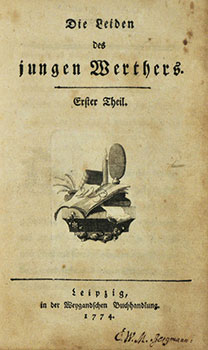 On October 29th 1772, after spending the evening drinking wine and writing letters, Wilhelm Jerusalem, still only in his twenties, put a gun to his own head and pulled the trigger. He was not killed instantly, but was able to drag himself across the floor of his study before collapsing unconscious next to a window, where he was found the following morning by a servant. He survived only a few more hours, and was buried later that day. Jerusalem was driven to suicide by his love for Elizabeth Herd, a married woman. She had rejected his advances and asked her husband to ensure that he did not trouble her again. An ugly confrontation followed, which left Jerusalem a broken man. An acquaintance later wrote of his death that it "was loneliness…that ate away his heart".
On October 29th 1772, after spending the evening drinking wine and writing letters, Wilhelm Jerusalem, still only in his twenties, put a gun to his own head and pulled the trigger. He was not killed instantly, but was able to drag himself across the floor of his study before collapsing unconscious next to a window, where he was found the following morning by a servant. He survived only a few more hours, and was buried later that day. Jerusalem was driven to suicide by his love for Elizabeth Herd, a married woman. She had rejected his advances and asked her husband to ensure that he did not trouble her again. An ugly confrontation followed, which left Jerusalem a broken man. An acquaintance later wrote of his death that it "was loneliness…that ate away his heart".
These events would not warrant even a footnote in the annals of doomed love were it not for the fact that the acquaintance was Johann Wolfgang Goethe, who at this time was also suffering the pangs of unrequited love. He had met and fallen in love with Charlotte Buff in the early summer of that same year, while living in the small German town of Wetzlar. "Lotte" was nineteen years old, attractive, funny and vivacious, but already engaged to another man, Christian Kestner. Goethe befriended them both, and spent what he later described as an idyllic summer in their company. However, when he eventually declared his feelings to Lotte, she made it clear that there could never be anything more than friendship between them.
Goethe responded to this setback by leaving unannounced for Koblenz, writing to Lotte: "I am alone now, and may shed my tears. I leave you both to your happiness, and will not be gone from your hearts". In fact, he was hardly gone at all, maintaining a correspondence with them both over the next few months. In this way, he came to learn of the suicide of Jerusalem, whom he had met occasionally during his summer in Wetzlar, and was immediately struck by the similarity of their two situations. He returned briefly to the town, and with the help of Kestner was able to piece together the circumstances that led to Jerusalem's death.
We know all this because Goethe drew upon his love for Lotte, and the suicide of Jerusalem, as the inspiration for The Sorrows of Young Werther, literature's exemplary treatment of the pain and perils of doomed love. Partly autobiographical, partly biographical, the novel tells the story of Werther's descent into despair, and his eventual suicide, as he realises that there is no escape from the torment engendered by his one-sided passion for a sweet-natured, but unattainable, young woman. In the first half of the book, Werther is Goethe, in the second half, he is Jerusalem, and the young woman, of course, is Lotte.
The novel was an instant success, establishing Goethe's international reputation. The fact that its origins lay in real-life events quickly became the catalyst for the emergence of a Werther cult. The young men of Germany began to imitate Werther's style of dress: blue frockcoat, yellow waistcoat and breeches. There were plays, poems and paintings inspired by the romantic hero, and even pilgrimages to the grave of Wilhelm Jerusalem, where flowers were left and speeches given. It is also said that the novel inspired an epidemic of copycat suicides amongst the lovelorn youth of Europe, and while there isn't a lot of evidence to support this contention, it is certainly true that worries about this darker aspect of Werther fever led to the book being banned in Denmark, Italy and parts of Germany.







